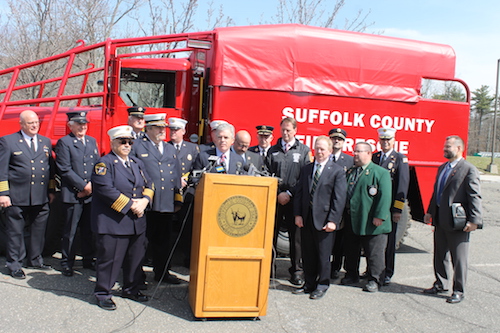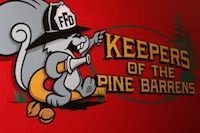Suffolk County and the N.Y. Central Pine Barrens Commission are partnering to provide a permanent wildfire training course on county-owned land near the county fire academy in Yaphank.
The permanent training course will be developed on 25 acres of land south of the Suffolk County Fire Academy. It’s needed to train the more than 10,000 volunteer firefighters in Suffolk, most of whom have had little or no opportunity for training on brush trucks — except on the scene of an actual wildfire, Suffolk County Executive Steve Bellone said today.
 Bellone, flanked by N.Y. Central Pine Barrens Commission chairman Peter Scully, commission executive director John Pavacic and fire service officials made the announcement at a press conference outside the H. Lee Dennison building in Hauppauge this morning.
Bellone, flanked by N.Y. Central Pine Barrens Commission chairman Peter Scully, commission executive director John Pavacic and fire service officials made the announcement at a press conference outside the H. Lee Dennison building in Hauppauge this morning.
“We’re here to announce a proactive approach to further protect our residents, businesses and land in Suffolk County,” Bellone said. “We have been and continue to be vulnerable to massive wild fires that have the potential to be catastrophic,” he said.
“Three years ago, almost to the day, over 1,100 acres of the Long Island Central Pine Barrens in the Ridge-Manorville area were destroyed by wildfires,” Bellone said. “Just this past weekend a brush fire in Flanders blazed through 10 acres.
“We need to be even more prepared to deal with the event of a catastrophe and be prepared to work to prevent that from happening and make sure that our fire personnel, as they go in to do their work, have what they need and have the training that they need to combat those wildfires,” Bellone said.

Scully said the training course is “an outgrowth of the strong leadership that the county executive showed both during [the 2012 Manorville wildfire] event and following that event to look at ways in which we can better prepare the community to deal with those kind of threats.”
The training course is part of a “multi-pronged effort,” Scully said, that also includes forest management activities aimed at “trying to eliminate accumulated fuels which make fires more difficult to deal with.” Scully noted that this has been “an ongoing concern in the Flanders area.”
A succession of Flanders Fire Department chiefs have asked the state and county to remove dead oak trees littering the preserved pine barrens on state- and county-owned land in the Flanders Fire District since a massive oak die-off nearly a decade ago left dead oak trees standing throughout the pine barrens. The Flanders area was documented by the state Department of Environmental Conservation in 2008 as a large area of “hardwood mortality.”
The standing dead trees are called “widow-makers” by firefighters because of their potential to fall and kill firefighters who are in the woods battling brush fires. The Flanders Fire Department has retrofitted its brush trucks with cages to enclose and protect firefighters during wildfire incidents.

Pavacic, state Central Pine Barrens Commission executive director, said today the Flanders area would be the first area of attention pursuant to a $697,000 contract entered into by the commission in 2013.
“A qualified contractor is developing a plan to do a number of things,” Pavacic said of the study and plan. Among them are prescribed fires — planned burns — which are aimed at reducing fuel load on the forest floor; as well as trimming to thin the understory and flammable natural vegetation. The commission will reach out to the fire district and the civic association once the plans are more fully developed by the end of the year, Pavacic said.
The contractor, Land Use Ecological Services, will identify the “most efficient travel-ways,” Pavacic said. They will be “designated as formal travel-ways for fire equipment, for brush trucks and so forth,” he said. “We would look to remove those hazards [dead trees] so fire trucks won’t get hung up on them” as they did this weekend in Flanders. Two brush trucks got stuck on dead wood during the wildfire operation Saturday. Riverhead Fire Department’s brush truck was incapacitated and had to be towed out of the woods by another brush truck.
“At the same time, an issue we’re dealing with is illegal activities,” Pavacic said, such as ATVs, off-road vehicles and dumping.
“We’re trying to balance those things,” he said. “We need to provide access for legitimate purposes for wildfire fighting but at the same time we need to reduce illegitimate access for illegal activities.”
Pavacic noted that some of the downed trees have “actually started to decompose” after making contact with the ground.
“You also have to remember this is natural land, set aside for ecological purposes,” Pavacic said. “A number of these trees also provide habitats for different types of organisms, including woodpeckers, flying squirrels, owls and so forth,” he said. “So that’s the balancing act.”
Even if it were viable from an environmental standpoint to remove all the dead trees, it would be cost-prohibitive, Pavacic said.
 Flanders Fire Chief Joe Pettit said existing fire breaks and fire lanes, which had been in the area for decades, have been allowed to grow in. What’s worse, he said, is land managers have actually intentionally blocked the fire lanes to prevent ATVs from using them. The result, he said, is ATV riders tearing up even more of the woods, effectively making a lot of other paths and trails because they can’t use the ones that had once been cleared for fire trucks.
Flanders Fire Chief Joe Pettit said existing fire breaks and fire lanes, which had been in the area for decades, have been allowed to grow in. What’s worse, he said, is land managers have actually intentionally blocked the fire lanes to prevent ATVs from using them. The result, he said, is ATV riders tearing up even more of the woods, effectively making a lot of other paths and trails because they can’t use the ones that had once been cleared for fire trucks.
“It makes no sense,” Pettit said.
He didn’t care to comment on the idea of “balancing” firefighters’ lives with protecting habitat for woodpeckers, flying squirrels and owls.
“This is relatively new,” the fire chief said. “The habitat that’s been created is something we never had in the past.”
Pettit said local firefighters can’t use the same tactics used in other parts of the country, where firefighters will let 50 or 60 acres burn while they get ahead of the fire, dig a line and let it burn till it gets there.
“They have time to do that,” Pettit said. “We’re almost in an urban situation. We have houses very close to our woods. Our methods of firefighting have to be very different. There’s no way we can afford to have that much property burn up without putting homes and lives in jeopardy.”
Flanders Fire Department had had seven or eight firefighters take the county’s wildfire training course over the past couple of years, Pettit said.
“Our problem is not lack of training or lack of experience. It’s the condition of the forest,” Pettit said. He said while it would be cost-prohibitive to remove all the dead trees, he believes the county and state could at least remove the dead trees from the fire lanes.
Pavacic said the property owner, not the pine barrens commission, is ultimately the responsible party for conditions in the woodlands.
The county executive was not available for comment after today’s press conference.
The survival of local journalism depends on your support.
We are a small family-owned operation. You rely on us to stay informed, and we depend on you to make our work possible. Just a few dollars can help us continue to bring this important service to our community.
Support RiverheadLOCAL today.

































